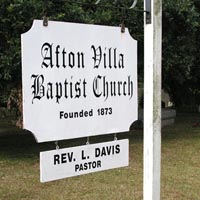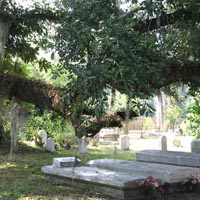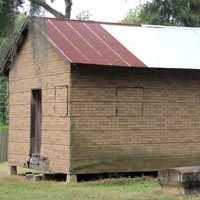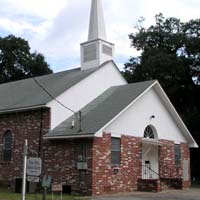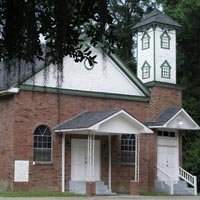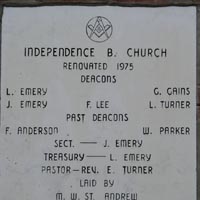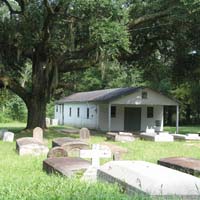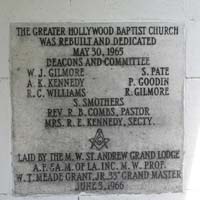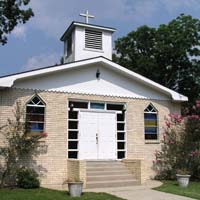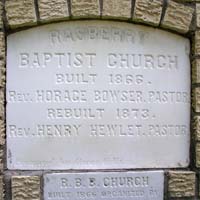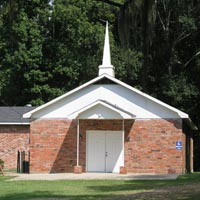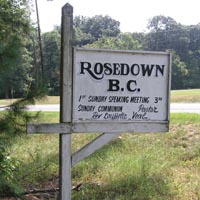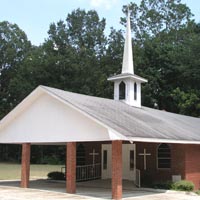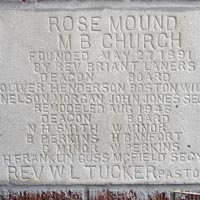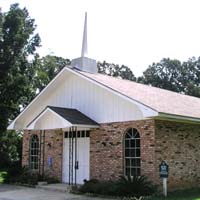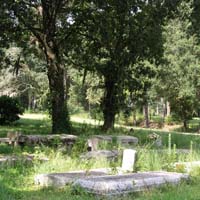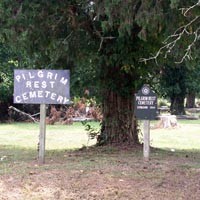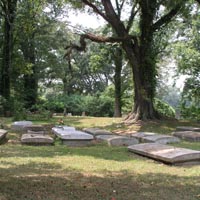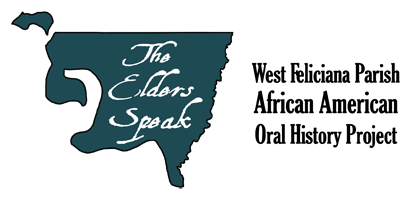
The Elders Speak: The West Feliciana Parish African American Oral History Project
By Teresa Parker Farris

Religion
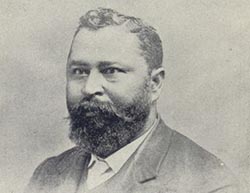
Like much of Louisiana north of Baton Rouge, West Feliciana Parish is overwhelmingly Protestant, in particular Baptist and Methodist, owing to the large number of former Tidewater planters who settled the area. Many of the parish's African-American churches originated on these Anglo-Protestants' plantations as informal communities of faith that worshiped in slave quarters or brush arbors. Following the Civil War, the Baptist Church flourished through the efforts of Dr. H.C. Cotton, a native of the parish town of Bayou Sara who would later be described as "the Moses of this great Baptist host." Cotton, who served three terms as the President of Louisiana Baptist State Convention, helped organize the worshipers into churches, ordained preachers, and disseminated doctrine. The influence of the Baptist Church remains evident in the religious affiliations of the project interviewees.
Baptism & Religion
An important rite of passage in the interviewees' lives, baptism signified an acceptance of God and repudiation of former sins. Individuals described wearing traditional white robes for ceremonies that took place in ponds or creeks near their churches. There they were fully immersed in the water—a practice once common in African American communities across the South. Baptisms were followed by a regular church service that often included the Right Hand of Fellowship, a ritualized handshake between the newly baptized and church elders, symbolizing acceptance into the congregation.
Many of the project participants were baptized as children, while others waited until they were adults. Moreover, they were baptized both in large groups and individually. Most of the interviewees reported that they still attended service at the church where they were baptized, and many noted that there they had served in official capacities such as deacon or deaconess or participated in the choir where they sang a variety of spirituals and hymns.
Audio PlayerZack Cavalier describes his call to God while picking cotton and his family's subsequent conversion.
Audio PlayerEllen Hardy recalls her mother's singing in the church choir as well as her and her sister's pond baptisms.
Audio PlayerElizabeth Lee describes attending religious revivals in the summer and wearing a white-gown for her baptism.

Afton Villa Baptist Church
The oldest African American church in the parish, Afton Villa Baptist originated from a congregation that had worshipped together in the woods of Clover Hill Plantation (now the Girl Scouts Camp Marydale). On February 9, 1871, Susan A. Barrow, the mistress of Afton Villa plantation, donated land near her home so that the group could build a church. The congregation then split, with half founding Afton Villa in 1873 and the remaining members establishing Sage Hill Baptist Church shortly thereafter. The original church house was a small, one-room structure. It was replaced in 1890 by a larger building that was bricked in 1970. The church was rededicated in 1980.
The church is located at 7493 Old Highway 61 (5.5 miles north of St. Francisville on U.S. Highway 61, across from and 0.2 miles past Afton Villa gardens).
Independence Baptist Church
Independence was chartered in 1887 but did not occupy its present site until 1908. On March 6, 1920, the congregation was formally incorporated with a mission of buying land on which to erect a new church as well as a school. Sarah H. Diedritch Lewis Barrow, of Ambrosia and Independence Plantations, helped them realize this goal when she donated 1.09 acres, valued at $50, on April 30, 1920. A new structure was then constructed, approximately 50 feet east of the original building. The church was bricked in 1975, at which time a back section with indoor bathrooms was added.
The church is located at 10345 LA Highway 965 (1.9 miles south of St. Francisville, left onto LA Highway 965 for .1 mile).
Old Hollywood Baptist Church
The Hollywood Baptist congregation was organized in 1867. According to the institution's official history, a church building was constructed but destroyed by fire. A second building was erected but by the 1960s had fallen into disrepair. The third and final edifice is a brick church, consecrated on May 30, 1965. The membership did not have clear ownership of this property, but landlord Willie Dawson allowed the congregation to worship there as long as each party was in agreement. Title to the property was transferred in 2002.
The church is located on Hollywood Church Road (turn right onto dirt road 1.0 miles past Greater New Hollywood Baptist Church at 8819 Sligo Road).
Rasberry Baptist Church
Organized in 1866, Rasberry is the oldest independent African American church in the parish: unlike Afton Villa Baptist or Sage Hill Baptist, it was never affiliated with a plantation. For reasons not documented in the church's history, the structure was rebuilt in 1873, in 1890, and again in 1965. In the 1930s and 40s, Rasberry was closely affiliated with the black grade school established in the late 1880s, which stood on the site now occupied by the parish jail. The school's principal was John S. Dawson, formerly of the Laurel Hill School, who also served as Senior Deacon and Sunday School Superintendent in the church.
The church is located on Hollywood Church Road (turn right onto dirt road 1.0 miles past Greater New Hollywood Baptist Church at 8819 Sligo Road).
Rosedown Baptist Church
In 1800, the owner of Rosedown Plantation gave his slaves permission to form a religious congregation and erect a small church in the quarters behind the main house. In 1901, the congregation moved to a location on the plantation grounds a mile away and formally consecrated a new structure. The present-day church, which is a modern brick edifice, sits on the same property. In December of 1993, the congregation purchased the one-acre site.
The church is located on LA Highway 10 (1.0 mile from U.S. Highway 61 on the left).
Rosemound Baptist Church
The parish's third oldest church, Rosemound (also known as Laurel Hill) was built on land once owned by the Argues, a white family who ran the nearby general store and post office. The congregation bought the property from Laura E. Argue in 1882, but the church's cornerstone states that the church was not formally established until May 27, 1891. It was at this church that educator John S. Dawson began his 58-year career as a teacher. According to his obituary in the St. Francisville Democrat, he taught in the church from January of 1890 until around 1895 when a separate schoolhouse, the Laurel Hill School, was erected.
The church is located at 11188 Old Laurel Hill Road (on the right, .8 mile from U.S. Highway 61 turn-off, 1.5 miles past Masonic Lodge).
Sage Hill Baptist Church
Following emancipation, slaves from the Clover Hill plantation separated into two worship groups. In 1871, one established Afton Villa Baptist and, several months later, the other founded Sage Hill, thus considered the second oldest black church in the parish. The current church house was built in 1980 to replace the original wooden structure.
The church is located at 7708 Sage Hill Road (on the right, 1.6 miles off of Bains Road).
Spirituals
As religion was central to the lives of most of the interviewees, so, too, were the spirituals and hymns they sang in church as choir members or congregation members. Most of the songs they described have had a long history within the greater African-American community. "Let the Light of the Lighthouse Shine on Me," for example, is thought to have been used by Harriet Tubman to communicate with slaves in search of the Underground Railroad. Further, the call-and-response style of "Jesus is on the Main Line" make it likely the song was a nineteenth-century field holler prior to its recording in 1937. Other songs referenced by the interviewees were more recent releases like "Rough Side of the Mountain" from 1984.
Audio PlayerAlice Johnson sings "Rough Side of the Mountain."
Audio PlayerEllen Hardy sings "What a Friend We Have in Jesus."
Audio PlayerTurlie Richardson sings "Just a Closer Walk with Thee."
Audio PlayerSally Smith sings "On the Battlefield for My Lord."
Audio PlayerZack Cavalier sings "Let the Light of the Lighthouse Shine on Me."
Audio PlayerLouise Williams sings "Jesus is on the Main Line."

Funerals
Funerary rituals traditionally consisted of a wake or visitation, church service, and burial. Interviewees described intimate, modest events with wakes held in private homes, rather than churches, and hearses of simple wagons driven by friends or family members. As West Feliciana Parish had no African American embalmers until the 1960s, services were frequently held within twenty-four hours of death so that the uninterred body would not begin to decompose. Funerals also frequently took place on the weekends so attendees would not miss work. The deceased members of the parish's African American community are buried in church graveyards as well as St. Francisville's historically black cemetery, Pilgrim's Rest. Many of the interviewees recalled that funeral expenses were paid by local burial insurance organizations such as the Old Benevolent Society.
Audio PlayerTravis Carter remembers attending wakes in person's homes and how wagons were used to transport bodies to the cemetery.
Audio PlayerZack Cavalier recalls his childhood fear of the wakes held at his house and relates that funeral services were sometimes preached a month after burials.
Audio PlayerEllen Hardy explains that before Max Johnson became the parish's first African American undertaker, bodies had to be taken to the Scott's Bluff area of Baton Rouge for embalming.

Pilgrim Rest Cemetery
Established in 1904, Pilgrim Rest Cemetery primarily serves African American churches, such as Rasberry Baptist and St. Andrews Baptist, within the city limits of St. Francisville. The cemetery sits on land donated in the early 1900s by a member of the Williams family (proprietors of the Myrtles Plantation from 1889 until the 1950s). A number of tombstones incorporate the symbolic imagery of the Freemasons and its sister organization the Eastern Stars. Noteworthy graves include that of West Feliciana Parish African American educator John S. Dawson for whom the former high school was named.
The cemetery is located on North Commerce Street between Barrow and Dimple Drive, 1.1 miles from intersection with Ferdinand Street.



